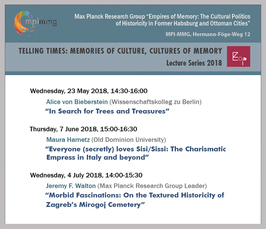"Morbid Fascinations: On the Textured Historicity of Zagreb’s Mirogoj Cemetery"
Lecture Series "Telling Times: Memories of Culture, Cultures of Memory"
- Datum: 04.07.2018
- Uhrzeit: 14:00 - 15:30
- Vortragende(r): Jeremy F. Walton (Max Planck Research Group Leader at MPI-MMG)
- Jeremy F. Walton is the leader of the Max Planck Research Group, “Empires of Memory: The Cultural Politics of Historicity in Former Habsburg and Ottoman Cities,” at the Max Planck Institute for the Study of Religious and Ethnic Diversity (MPI-MMG) in Göttingen, Germany. Prior to his current position, he held research and teaching fellowships at the Center for Advanced Studies of Southeastern Europe at the University of Rijeka, the CETREN Transregional Research Network at Georg August University of Göttingen, Georgetown University’s Center for Contemporary Arab Studies, and New York University’s Religious Studies Program. He received his Ph.D. in Anthropology from the University of Chicago in 2009. Dr. Walton’s first book, Muslim Civil Society and the Politics of Religious Freedom in Turkey (Oxford University Press, 2017), is an ethnographic exploration of the relationship among Muslim civil society organizations, state institutions, and secularism in contemporary Turkey. He has published his research in a wide selection of scholarly journals, including American Ethnologist, Sociology of Islam, The Cambridge Journal of Anthropology, and Die Welt des Islams. “Empires of Memory,” which Dr. Walton designed, is an interdisciplinary, multi-sited project on the cultural politics of post-imperial memory and history in eight former Habsburg and Ottoman cities: Vienna, Istanbul, Budapest, Sarajevo, Trieste, Thessaloniki, Zagreb, and Belgrade. His research in the context of “Empires of Memory” examines the ambivalent legacies and modes of amnesia that emerge from specific sites of memory in each of these cities.
- Ort: MPI-MMG, Hermann-Föge-Weg 12, Göttingen
- Raum: Conference Room

For more details please contact cziesielsky(at)mmg.mpg.de.
Perched on the forested slopes of Medvednica Mountain, Zagreb’s Mirogoj Cemetery, designed by eminent Franco-German architect Hermann Bollé and first opened in 1876, is one of the crown jewels of the city’s Habsburg architectural heritage. Mirogoj’s elegant arcades and oxidized copper-plate domes feature prominently in tourist-oriented literature about the city, and a trip to the cemetery is a standard feature on many Zagreb tours. In this essay, I explore the intersections and tensions between Mirogoj as a site of leisure and as a site of memory. To begin, I situate the cemetery against the backdrop of the broader appreciation, revaluation, and commodification of Zagreb’s Habsburg built environment and legacy in recent years. Following Pamela Ballinger’s arguments concerning Habsburg nostalgia in Trieste, I argue that this selective commodification of the city’s past silences other urban histories and memories. In the second part of the paper, I seek out silenced pasts in Mirogoj itself, with a focus on graves no longer tended: those of bygone Jewish, Orthodox, and Muslim communities. While remaining vigilant in my avoidance of a romance of erstwhile sepulchral cosmopolitanism, I amplify the narratives and affects of these multiconfessional graves as a foil to the recent nationalization and Catholicization of the cemetery, embodied most visibly in the monumental tomb of Croatia’s first president, Franjo Tuđman. In doing so, I invoke and expand on my signature concept of “textured historicity” as it applies to the distinctive temporal palimpsest of Mirogoj.